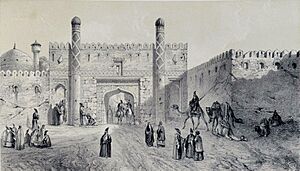Ottoman–Persian War (1743–1746) facts for kids
Quick facts for kids Ottoman-Persian War of 1743–1746 |
|||||||||
|---|---|---|---|---|---|---|---|---|---|
| Part of the Ottoman–Persian Wars and the Campaigns of Nader Shah | |||||||||
 Gates of Tabriz |
|||||||||
|
|||||||||
| Belligerents | |||||||||
| Commanders and leaders | |||||||||
| Nader Shah Nassrollah Mirza |
Mahmud I
|
||||||||
| Strength | |||||||||
| 375,000 | Unknown | ||||||||
The Ottoman–Persian War of 1743–1746 was a major conflict. It was fought between the Ottoman Empire and Afsharid Iran. This war lasted for three years, from 1743 to 1746.
Contents
Why the War Started
Religious Differences and Demands
Before the war, Persia tried to make a peace agreement. They wanted the Ottomans to accept a new religious idea. This idea was about the Ja'fari school, a branch of Islam. Persia wanted it to be seen as a fifth official group within Islam.
Nader Shah's Goals
In 1743, Nader Shah, the ruler of Persia, declared war. He demanded that the Ottomans give back the city of Baghdad. Persia had captured Baghdad in 1623 and Mosul in 1624. However, the Ottomans had taken Mosul back in 1625 and Baghdad in 1638.
Previous Peace and Conflicts
A peace treaty, the Treaty of Zuhab, was signed in 1639. This treaty brought peace for 85 years between the Ottomans and the Safavid Empire (Persia's earlier rulers). Later, Russia and the Ottoman Empire had agreed to divide parts of Persia. But when Nader Shah became powerful, both Russia and the Ottomans left those areas.
Nader Shah had fought the Ottomans before, from 1730 to 1736. That war ended without a clear winner. After that, Nader Shah turned his attention east. He invaded India and the Mughal Empire. He did this to get money to pay for his wars against the Ottomans.
Key Events of the War
Nader Shah's Grand Plan
Nader Shah dreamed of building a huge empire. He wanted it to stretch from the Indus River in India to the Bosphorus strait in Turkey. To achieve this, he gathered a large army of 200,000 soldiers. Many of these soldiers were from Central Asian tribes.
Change of Plans
Nader Shah first planned to march towards Constantinople, the Ottoman capital. But he learned that Ottoman religious leaders were preparing for a holy war against Persia. Because of this, he changed his direction and turned east.
Early Battles and Sieges
Nader Shah's forces captured Kirkuk and Arbil. On September 14, 1743, they began to besiege Mosul. The siege of Mosul lasted for 40 days. The Pasha (governor) of Mosul, Hajji Hossein Al Jalili, successfully defended the city. Nader Shah's army was forced to retreat.
Revolts and Pauses
The Persian attack stopped because of revolts in Persia. These revolts happened in 1743 and 1744. People were unhappy about the high taxes Nader Shah was collecting. Fighting also spread into Georgia. There, a prince named Givi Amilakhvari tried to use Ottoman help. He wanted to weaken Persian control and remove Nader's Georgian allies, Princes Teimuraz and Erekle. However, his efforts were not successful.
Later Campaigns and Peace
In July 1744, Nader Shah started his attack again. He unsuccessfully besieged Kars. But he had to go back to Dagestan to stop another revolt. After dealing with the revolt, he returned. In August 1745, he defeated an Ottoman army at the Battle of Kars.
End of the War
After this battle, the war began to fall apart. Nader Shah started to act strangely and punished his own people harshly. This led to more revolts from early 1745 to June 1746. Finally, peace was made in 1746. The borders between the empires did not change. Baghdad remained under Ottoman control. Nader Shah also dropped his demand for the Ja'fari religious idea to be recognized.
The Ottoman government was pleased with the peace. They sent an ambassador to Persia. However, before the ambassador could arrive, Nader Shah was killed by his own officers.
See also
- Nader Shah
- Ottoman-Persian Wars

